Nicolas Blouin
University of Rhode Island
In a former life as a freelance photographer, Nic became increasingly interested in the natural beauty of marine macroalgae during trips to the shore. He began using seaweeds as subject matter in cyanotype images in similar ways that naturalists like Anna Atkins had done over 150 years ago. This fed into his naturalist’s curiosity regarding the complex ecology in the intertidal zone where organisms are subjected to daily fluctuations in temperature and nutrients, predation, and competition. Now, Nic’s interests broadly relate to life history evolution and how these adaptations function to provide mechanisms for organisms to persist as members in complex intertidal communities. He is currently focusing on a group of red seaweeds that have evolved to abandon photosynthesis and parasitize their closest evolutionary neighbors (adelphoparasitism). His interests here are principally related to the developmental similarities between the adelphoparasite and host life history stages, and how these evolutionary adaptations are conserved across both other adelphoparasites and alloparasites (those parasites infecting more distantly related red algae). In other words: what can change and which aspects of life history are constrained when an organism abandons a free-living life style? In a related project concerning organellar (plastid and mitochondrion) maintenance, Dr. Blouin and his colleagues are looking into the evolutionary trajectories of genes that have been transferred to the nucleus but still function in organelles. Dr. Blouin was a residence in September, 2012. VIDEO INTRODUCTION
